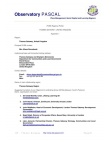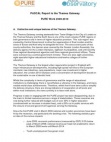Thames Gateway, London
The Thames Gateway was “created” in 1995. The principles of the Gateway spatial framework were established in Regional Planning Guidance (RPG9a), and are based around the consolidation of the existing regional pattern of town and country, maximising the potential offered by the area's supply of brownfield land and exploiting the opportunity offered by the new Channel Tunnel Rail Link (CTRL) and the river, first published in 1995. RPG9a was also the first document to define the Thames Gateway boundary (although it has changed slightly since).
The Thames Gateway spans around 17 local authority areas (lower tier district councils, upper tier county councils, unitary authorities and London boroughs). It also spans three Government Office Regions. No single authority is wholly contained within the Thames Gateway boundary.
The Gateway as a coherent policy area is a fairly new construct and technically dates from 1995. Prior to that, while the estuary had throughout the 20th century been subject to wide ranging attempts at what we now would call sustainable place making (Dagenham and Becontree Estate, Basildon New Town, East Tilbury model village, Thamesmead, and latterly Docklands), these were all unconnected and were not perceived or managed in a strategic way. Nor were they very successful.
The Gateway as a strategic policy area was a consequence of the pairing of Michael Heseltine as Secretary of State, and Sir Peter Hall as his planning advisor, at the same time as two major pieces of transport planning - the Channel Tunnel rail Link, and the East London Rail Study - were being drawn up. In the early 90's, fresh from the growing perception that Docklands was actually working they hit upon the idea of developing a strategic transport led approach to the development of the massive underused land and resources in the Estuary. They coined the Gateway name, commissioned the Llewellyn Davies study and decided the CTRL should provide the new backbone for a regional regeneration initiative. Even then it was not until the arrival of the RDAs that the Government turned its mind in 2000 to how to drive a strategic agenda, and set up the 'Thames Gateway Strategic Executive'.
The other point to acknowledge is the estuary's historical military role. The area never developed significantly outside a few locations largely because of its vulnerability. Historically it has been a line of defence rather than area of development, leading to a reliance on military based economy. It was the collapse of these economies in the sixties/ seventies in Chatham and Woolwich in particular - among the most drastic sudden loss of employment in the whole country- that helped trigger the Heseltine initiative (which included an Enterprise Zone being established in Chatham).
 Printer-friendly version
Printer-friendly version- 156 reads










